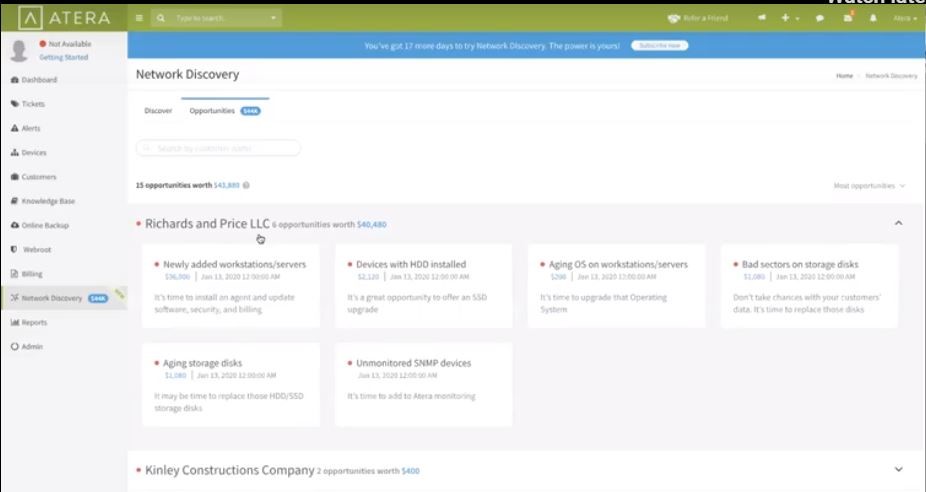By Harry Brelsford
Stick with me on this hidden money maker for Managed Services Providers (MSPs) using Atera’s Network Discovery in a Third-Party Maintenance (TPM) / extended warranty scenario.
Executive Summary
- There are significant automation-based workflows to create immediate MSP opportunities.
- The upfront assessment using an RMM network discovery tool is the first step.
- Work with your client as a technology business advisor to suggested ways to extend the life of existing IT assets
What is TPM?
TPM is ongoing hardware support for technology equipment that acts as both an alternative and enhancement to original equipment manufacturer (OEM) support. It’s analogous to an extended warranty.
I have first-hand witnessed how this important add-on not only takes care of your customers but is a secret source of revenue. Back in the Windows XP Migration-era (April 2014+), I was advising Microsoft OEM on the Dell Team. Much of the upgrade strategy including selling Dell extended warranties and that was highly profitable.
Let’s put our MSP hat on and do some extended warranty math with Windows XP as an example.
• Windows XP End of Life (EOL) was April 14, 2014
• Let’s assume your client finally got around to upgrading to a new Dell Laptop with Windows 10 in late July 2015 (when Windows 10 shipped as you didn’t want your client to run Windows 8 – this is a true story)
• Dell has a standard one-year mail in service warranty so you would be covered until late July 2016.
• But being a competent MSP, you purchased the four (4) year ProSupport Plan with the Next Business Day Onsite Service extended warranty that covers your client’s computers until late July 2019.
• When that extended warranty expired (in July 2019), you used Atera’s new Network Discovery tool to take a hardware and software inventory of your client’s technology assets. It identified the fleet of Dell laptops that were losing warranty coverage.
• You wisely purchased a TPM from a reputable distributor that sells TPM contracts with significant upside for the MSP (along with other MSP protections). This allowed your client to cost-effectively extend the life of its technology assets and not have to invest in new equipment. (And as you’ll see below, it was a very wise recommendation from you the MSP). Assume your new TPM contract is for an additional 36-months or three-years.
Why TPM Now?
If you closely followed that above timeline, you had your client enter into a three-year TPM contract extending coverage to July 2022. This is an important part of the story as you helped your reduce client’s capital outlays and YOU GOT LUCKY!
Here is what I mean about luck. In mid-2019, unbeknownst to you, you were engaging in a hedge strategy to reduce risk. Think about it. In the real world, you purchase insurance for your health to reduce financial exposure and stay healthy. TPM agreements have some of the same motion.
Your lucky client with extended protection is implicitly enjoying a pandemic recession divided by reducing their IT spend in a steep and deep recession. Now let’s translate forward looking statements about moving your MSP business successfully in a recession. TPM agreements are countercyclical. It’s a simple theory. In a recession, you and your clients are going to reduce costs. So instead of a hardware refresh, how about extending the life of existing technology assets? Trust me – you can sell that all day, every day. In a moment, I’ll show you the TPM revenue lift you can anticipate accruing.
What is Network Discovery?
In 2019, Atera introduced Network Discovery and its essentially taken SNMP network sniffing to a whole different level! Network Discovery finds devices connected to a network. It scans the entire network, identifies its components, and creates an inventory—with detailed information on each network device. It also re-scans the client’s network periodically and updates the equipment log.
To use Network Discovery, you'll need an Atera agent installed on your customer's domain controller (DC). That is the agent that will perform the scan. You can learn more about Network Discover HERE on the Atera product page.
You should also soak in my Atera Network Discovery review HERE where I use this cool tool with a real world MSP Andy Higgins from Dripping Springs, TX. And a highlight shoutout in my review to how Atera has enhanced SNMP device discovery to include an opportunity generator and identify hardware and software upgrade opportunities (a strategy that is very much still valid). But I want to go in a different direction with the business development motion.
Introducing Atera
Atera is a ten year old independent software vendor (ISV) that started in the Remote Management and Monitoring (RMM) area and has since expanded behave more as a technology platform for MSPs with the inclusion of additional functionality and features (such as Professional Services Automation (PSA)). Atera success can be attributed to, in part, its commitment to crowdsourcing product development ideas. It’s enthusiastic community drives development sprints where new capabilities are released monthly. Atera pioneered the “per technician” pricing model in the MSP community.
The Marriage of Network Discovery and TPM!
A new solution bundle for MSPs to protect customers, provide better service and the flight to enhanced profitability rests in the marriage of Network Discovery and TPM agreements. That’s because in addition to upselling customers with new equipment to replace old equipment, you can also sell TPM agreements to extend the technology asset life cycle after your run Network Discovery.
The secret sauce is to use Atera’s Network Discovery in the upfront assessment phase that allows the MSP to understand what the current situation is before entering into a TPM contract. Running Network Discovery on your customer’s network is effectively engaging in a risk assessment exercise. Armed with deep knowledge and visibility into your customer’s technology infrastructure, you can optimize the TPM contract purchase process by not under-insuring the client’s infrastructure or not buying more coverage then they need.
There is also a direct business conversation with the customer based on the reports you will generate (see Figure 1)

Figure 1: The Network Discovery view post assessment.
You can find the balance between having TMP contractual coverage for a specific duration (say another two years when some forecasts suggest the economy will start to perform well again) versus making the “buy” decision to acquire new hardware.
Financial Results
As shared in my Atera Network Discovery review HERE, it was shown the using Network Discovery resulted in $89,960 in additional revenue from upsell opportunities for the MSP. This was based on primary research and continuous data gathering by Atera and it’s MSP partners.
But the financial news just gets better. The revenue outlook improved nearly 40% (39.95%) to $134,883 in untapped sales opportunities, according to ScalePad, for the average MSP when the sale of TPM agreements are pursued. This is “found money” that is welcome during both great and challenging times.
Validation
“The TPM opportunity from end-to-end is absolutely an opportunity for our MSP business, FunctionOne.” Shared Joe Markert. “It’s a case of Captain Obvious! When you first approach a new customer and conduct an audit, it creates opportunities and highlights your ability to show immediate value. Why? Because the audit will find equipment outside it’s expected life cycle.”
“What were really talking about here is the asset lifecycle management story. The MSP can tackle this area from a couple vantage points. The first is documenting lost efficiencies and opportunity costs associated with old equipment. This represents an opportunity strategically reinvest.” Market shared.
“I view extended warranties and TPM as business continuity. Today, all businesses are looking to reallocate and reassign existing investments to get more bang for the buck. That starts with warranties and, again, allows the MSP some EASY WINS.” Said Market.
“Implementing an asset life cycle management program is really about a multi-year rolling replacement strategy. One strategy would be to align devices with a TPM extended warranty that matches the expectedlife of the equipment.” Concluded Markert, shown in Figure 2 below.

Figure 2: Joe Markert, CEO at FunctionONE.
In his own words, watch our interview with Markert HERE to enhance your understanding of the assessment and TPM motion.
[Note: In this case – Markert’s client audit is analogous to the assessment process described in this blog]
“Sometimes it feels like everything is out of warranty.” Wayne Longabard, Director of IT Engineering at Datasmith Network Solutions shared with a sense of humor. “The key is to leverage RMM automation in the assessment phase. A lot of tools don’t cover hardware like switches so that is a challenge.”
WARNING!
Time for a cautionary statement concerning Network Discovery and TPM agreements. I have a fiduciary obligation to encourage you to purchase TPM agreements and contracts from reputable technology distributors only. Why? Because there are entities that are private equity-backed who will seduce you buying into TPM contracts. This is very risky because non-distributor organizations that are private equity backed have a reputation for going directly to your clients when the TPM contract is up for renewal and bypassing you, the MSP. While I’m not endorsing any one technology distributor, start with your own technology distributor to see if TPM contracts are offered. To wrap on this conversation, understand that a reputable distributor will never go direct to your customers!
Conclusion
As of this writing, all businesses are seeing to operate more efficiently and contain expenses. MSPs can be part of the conversation by contributing life cycle asset management starting with the RMM-based assessments and placing selected hardware assets under TPM agreements to effectively lower costs and extend the useful life of equipment.
